消化系统The digestive system
医学英语消化系统图文解说

Text Study——Part 1
1. What are other terms for digestive tract?
Digestive tract is also termed as gastrointestinal tract, alimentary canal or gut(消化道).
They are also known as accessory organs, because they are not part of the digestive tract, yet have a role in digestive activities.
Unit Two
The Digestive System
Objectives
In this unit, we are going to learn to:
1. Grasp some medical terms related to digestive system.
2. Describe the function of the digestive system, and differentiate between organs of the alimentary canal and accessory digestive organs;
Text Study——Part 1——Translation
There are many people who are waiting to be admitted to the hospital ward.
许多人在等着入院。
Fat-soluble vitamins, which include vitamins A,D,E, and K, are usually absorbed with the help of foods that contain fat.
介绍消化系统作文英文

介绍消化系统作文英文英文:Digestive system is one of the most essential systemsin our body. It is responsible for breaking down the foodwe eat into smaller molecules that can be absorbed by our body. The digestive system consists of various organs including the mouth, esophagus, stomach, small intestine, large intestine, rectum, and anus.The process of digestion begins in the mouth where the food is chewed and mixed with saliva. The saliva contains enzymes that help break down the carbohydrates in the food. The food then passes through the esophagus and into the stomach where it is mixed with stomach acid and digestive enzymes. The stomach then churns the food into a liquid consistency and slowly releases it into the small intestine.In the small intestine, the food is further broken down by enzymes from the pancreas and bile from the liver. Thenutrients from the food are then absorbed into the bloodstream through the walls of the small intestine. The remaining waste products then pass into the large intestine where water is absorbed and the waste is formed into feces. The feces then travel to the rectum and anus where they are eliminated from the body.A healthy digestive system is essential for our overall health and wellbeing. Poor digestion can lead to a variety of health problems such as bloating, constipation, and diarrhea. It is important to maintain a balanced diet and stay hydrated to keep our digestive system functioning properly.中文:消化系统是我们身体中最重要的系统之一。
第13章 消化系统(翻译)
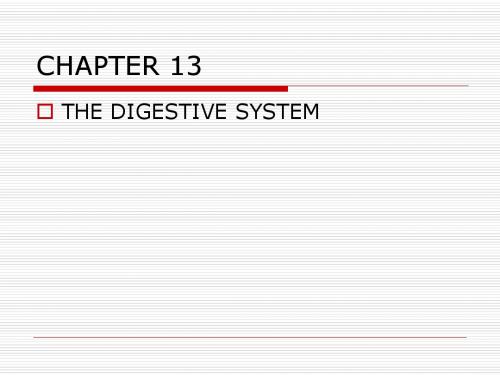
Common symptoms and signs of the digestive system
Nausea and vomiting Anorexia 食欲缺乏 神经性厌食症 anorexia nervosa 胃气胀 Gas and bloating =flatulency Constipation
A nonspecific chronic transmural(透 壁性) inflammatory disease that most commonly affects the distal ileum and colon but may occur in any part of the GI tract.
ANSWER:
CIRRHOSIS (of the liver)
Interested? OK! One more case!
Symptoms
Bouts of bloody diarrhea Abdominal cramps and pain Fatigue Weight loss Night sweats
Symptoms:
exhaustion fatigue loss of appetite nausea weakness weight loss abdominal pain spider-like blood vessels (spider angiomas) that develop on the skin
CHAPTER 13
THE DIGESTIVE SYSTEM
Exercise I
maze
Look at the diagram and tell the parts of the digestive system in the order that food passes through the body.
关于消化系统的英文PPT
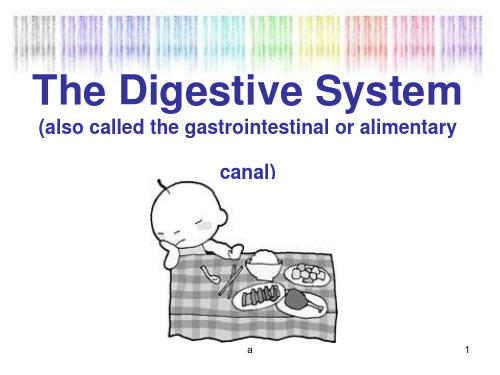
a
5
a
6
a
7
• The pharynx or throat ,is a long muscular tube that serves
as a passageway for food from the mouth to the esophagus and as a passway for air from nose to the windpipe.
• In the wall of the entire small intestine are millions of villi. It is through the capillaries in the villi that completely digested nutrients pass into the bloodstream and lymph vessels.
a
8
The stomach
It is composed of an upper portion called fundus,a middle section known as the body and a lower portion, called the antrum.
The cardiac sphincter relaxes and contracts to move food from the esophagus into the stomach ,whereas the pyloric sphincter allows food to leave the stomach when it sufficiently digested.
• The esophagus is a long muscular tube extending from the
鱼类学-消化系统PPT教学课件

鳃耙是鱼类的一种滤 食器官,亦有保护鳃丝的 作用。
鱼类鳃耙的数目、形 状与鱼的食性有一定关系。
9
鳃耙数
鳃耙的数目在鱼类分类上有时亦作为分类标志之 一。
鳃耙数:第一鳃弓的外鳃耙数。 上鳃耙数:咽鳃骨、上鳃骨上附生的鳃耙数。 下鳃耙数:角鳃骨、下鳃骨上附生的鳃耙数。
也有不分上下鳃耙记载的,记录第一鳃弓外鳃耙 总数。
鱼类的舌一般比较原始,没有弹性,不能活动。 少数鱼类舌退化甚至无舌,如海龙科。 一些鱼类的舌上布有味蕾,并有神经支配。 鱼类的味蕾不仅分布于舌上,在口腔、触须及 体侧等处均有分布。
8
(三)鳃耙(gill raker)
鱼类鳃弓朝口腔的一 侧长有鳃耙,一般每一鳃 弓长有内外两行鳃耙,其 中以第一鳃弓外鳃耙最长。
18
幽门盲囊(pyloric caeca)
大部分硬骨鱼类在胃后方、肠开始处的许多指状 盲囊突出物。或称幽门垂。幽门盲囊均开口于十二指 肠。
幽门盲囊的组织结 构与肠壁组织相似,其 作用一般认为是用来扩 大肠子的吸收表面积, 同时又能分泌与肠壁相 同的分泌物。
19
小肠
十二指肠: 内壁无突起,管径较细,胰管开口于此。 回肠: 管径较粗。 螺旋瓣(spiral valve) : 软骨鱼类及少数硬骨鱼类的肠 壁粘膜层及粘膜下层突出于管 腔的褶膜,一般排成螺旋状, 它有增加吸收面积的功能。螺 旋瓣排列状态和数目因种而异, 其排列形态大致可分为螺旋型 和画卷型两大类。
消化系统-英文版

the Alimentary Tract
The mouth, or oral cavity, is the first part of the digestive tract.It is adapted to receive food by ingestion, break it into small particles by mastication, and mix it with saliva.The lips, cheeks, and palate form the boundaries.The oral cavity contains the teeth and tongue and receives the secretions from the salivary glands.
The stomach is divided into the fundic, cardiac, body, and pyloric regions. The stomach has three layers of muscle: an outer longitudinal layer, a middle circular layer, and an inner oblique layer.The inner lining consists of four layers: the serosa, the muscularis, the submucosa, and the mucosa.The mucosa is densely packed with gastric glands, which contain cells that produce digestive enzymes, hydrochloric acid, and mucus. The stomach is a multi-functional organ, it stores food, breaks it down and then empties it into the small intestine.
介绍消化系统英语作文

介绍消化系统英语作文英文回答:The digestive system is a complex network of organs and tissues that work together to break down food intonutrients that can be absorbed into the bloodstream. The digestive system consists of the mouth, esophagus, stomach, small intestine, large intestine, and rectum.The digestive process begins in the mouth, where food is chewed and mixed with saliva. Saliva contains enzymes that begin to break down carbohydrates. The food is then swallowed and travels down the esophagus to the stomach.The stomach is a muscular organ that churnes the food and mixes it with gastric juices. Gastric juices contain hydrochloric acid and enzymes that further break down proteins and fats. The stomach also produces a hormone called gastrin, which stimulates the production of gastric juices.The food is then passed through the pyloric valve into the small intestine. The small intestine is a long, coiled tube that is lined with villi. Villi are small, finger-like projections that increase the surface area of the small intestine and help to absorb nutrients. The small intestine also produces enzymes that further break down carbohydrates, proteins, and fats.The food is then passed through the ileocecal valveinto the large intestine. The large intestine is a shorter, wider tube than the small intestine. The large intestine absorbs water and electrolytes from the food and stores waste products. The waste products are then passed through the rectum and expelled from the body.The digestive system is a vital part of the body. It provides the body with the nutrients it needs to function properly. Without a healthy digestive system, the bodywould not be able to absorb nutrients from food and would eventually become malnourished.中文回答:消化系统是一个由器官和组织组成的复杂网络,这些器官和组织共同作用,将食物分解成营养物质,以便吸收进入血液中。
消化系统(英文版) PPT课件

The large intestine is made up of three portions: the ascending, transverse and descending colon. It is the portion of the digestive system most responsible for absorption of water from the indigestible residue of food. The ileocecal valve of the ileum (small intestine) passes material into the large intestine at the cecum. Material passes through the ascending, transverse, descending and sigmoid portions of the colon, and finally into the rectum. From the rectum and anus, the waste is expelled from the body.
Liver is the largest gland in the body. On the surface, the liver is divided into two major lobes and two smaller lobes. It overlies and almost completely covers the stomach.
介绍消化系统英语作文

介绍消化系统英语作文英文回答:The digestive system is a complex network of organs and tissues that work together to break down food, absorb nutrients, and eliminate waste. It begins with the mouth, where food is chewed and mixed with saliva to form a soft mass called a bolus. The bolus then travels down the esophagus and into the stomach, where it is further broken down by stomach acids and enzymes.From the stomach, the partially digested food movesinto the small intestine, where it is mixed with bile from the liver and pancreatic enzymes from the pancreas. The small intestine is lined with tiny, finger-like projections called villi, which increase the surface area for nutrient absorption. The majority of nutrient absorption occurs in the small intestine.The remaining undigested material passes into the largeintestine, or colon. The colon absorbs water and electrolytes from the material, forming solid waste. The solid waste is stored in the rectum until it is eliminated through the anus.The digestive system is a vital part of the human body, as it provides the body with the nutrients it needs to function properly. Without a properly functioning digestive system, the body would not be able to absorb the nutrients it needs to survive.中文回答:消化系统是由器官和组织组成的复杂网络,它们共同作用,以分解食物、吸收营养物质和排出废物。
消化系统总论

X线特点(X-ray characteristic): 线特点( ) 软组织:缺乏自然对比( 1 软组织:缺乏自然对比(natural contrast); ) 两端开口,能运动:可引入造影剂 造影剂; 2 两端开口,能运动:可引入造影剂; 粘膜面:双对比( 发现早期 早期病变 3 粘膜面:双对比(double contrast)发现早期病变 消化腺:实质脏器,适于CT MRI、超声、 CT、 4 消化腺:实质脏器,适于CT、MRI、超声、血 管造影等项检查。 管造影等项检查。
b、全消(中上消化道):食管 、全消(中上消化道):食管 ): 回盲部
小肠系钡剂造影: 小肠系钡剂造影:
a:钡餐后; a:钡餐后; 钡餐后 b:小肠钡灌 小肠钡灌( b:小肠钡灌(Small intestine barium enema,SBE)
结肠造影:钡剂灌肠: 结肠造影:钡剂灌肠:Barium enema
1 粘膜破坏:粘膜皱襞消失 、中断,见于恶性肿 粘膜破坏: 中断, 瘤 2 粘膜平坦:粘膜及粘膜下水肿:逐渐移行与正 粘膜平坦:粘膜及粘膜下水肿: 常无明显分界 肿瘤浸润:固定,分界截然。 肿瘤浸润:固定,分界截然。 3 粘膜纠集:放射状向病灶集中,见于慢性溃疡 粘膜纠集:放射状向病灶集中,
31
4 增宽和迂曲(肥厚):炎症、肿胀、结缔组 增宽和迂曲(肥厚):炎症、肿胀、 ):炎症 织增生所致。 织增生所致。见于慢性胃炎和静脉曲张 5 微皱襞改变: 微皱襞改变: 炎症时:小区增大, 炎症时:小区增大,小沟增宽 伴糜烂时:小区小沟破坏、消失,呈散在点 伴糜烂时:小区小沟破坏、消失, 状钡影 癌瘤时:局部小区、小沟完全破坏、消失 癌瘤时:局部小区、小沟完全破坏、
消化系统专业英语
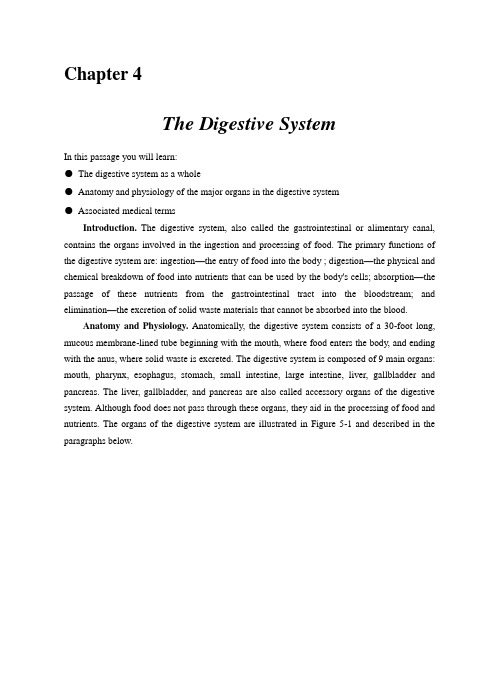
Chapter 4The Digestive SystemIn this passage you will learn:●The digestive system as a whole●Anatomy and physiology of the major organs in the digestive system●Associated medical termsIntroduction.The digestive system, also called the gastrointestinal or alimentary canal, contains the organs involved in the ingestion and processing of food. The primary functions of the digestive system are: ingestion—the entry of food into the body ; digestion—the physical and chemical breakdown of food into nutrients that can be used by the body's cells; absorption—the passage of these nutrients from the gastrointestinal tract into the bloodstream; and elimination—the excretion of solid waste materials that cannot be absorbed into the blood.Anatomy and Physiology. Anatomically, the digestive system consists of a 30-foot long, mucous membrane-lined tube beginning with the mouth, where food enters the body, and ending with the anus, where solid waste is excreted. The digestive system is composed of 9 main organs: mouth, pharynx, esophagus, stomach, small intestine, large intestine, liver, gallbladder and pancreas. The liver, gallbladder, and pancreas are also called accessory organs of the digestive system. Although food does not pass through these organs, they aid in the processing of food and nutrients. The organs of the digestive system are illustrated in Figure 5-1 and described in the paragraphs below.Figure 5-1The oral cavity. The process of digestion begins in the mouth, also called the buccal cavity, which is the opening through which food enters the body. The mouth has the ability to mechanically reduce the size of the food that is placed in it. The lips form the opening to the mouth, while the cheeks or bucca form the borders of the oral cavity. The structures within the oral cavity including the teeth, tongue, and palate, are involved in the chewing (mastication) and swallowing (deglutition)of food. They also play a role in speech.The teeth are used to cut, tear, and crush food into smaller pieces. They are classified mainly by their shapes and locations. Incisors and cuspids are in front of the mouth; molars are in the back. Each tooth consists of a mass of nerves and blood vessels, called pulp, surrounded by a hard substance called cementum and a white smooth substance called enamel. The teeth are embedded in fleshy tissue called gums or gingivae. Together, the gums and other structures that support the teeth are known as the periodontium. Humans have two sets of teeth, the deciduous dentition of child-hood , which fall out and are replaced by the permanent dentition of adulthood.The tongue extends across the floor of the oral cavity and is attached by muscles to the lower jaw bone. It manipulates food in the mouth during mastication and deglutition. The tongue is covered with a series of cone-shaped small projections called papillae in which there are taste buds that can sense flavors, such as sweet, bitter, salty, and sour.The palate forms the roof of the mouth. It is divided into two parts; the hard palate and the soft palate. The hard palate forms the anterior portion of the mouth, while the soft palate lies posterior to it. Hanging from the soft palate is a small tissue called the uvula. The word uvula means little grape. Around the oral cavity are three pairs of salivary glands. These exocrine glands produce a fluid called saliva, which is released, from the parotid gland, submandibular gland and sublingual gland on each side of the mouth. During swallowing, the soft palate and uvula move upward to prevent food from entering the nasal cavity, the uvula also helps to guide the food into the pharynx.The pharynx, or throat, is a long muscular tube that serves as a passageway for food from the mouth to the esophagus and as a passageway for air from nose to the windpipe (trachea). When swallowing occurs, a flap of tissue, the epiglottis, covers the trachea so that food can 't enter and becomes lodged there.The esophagus is a long muscular tube extending from the pharynx to the stomach. Food is propelled by rhythmic contractions of muscles in the wall of the esophagus. This process, called peristalsis, is also how food is moved through the stomach and intestines. It is something like squeezing a marble (bolus of food) through a rubber tube.The stomach, a pouch-like organ located in the upper part of the abdominal cavity, connects the esophagus with the small intestine. It is composed of an upper portion called fundus, a middle section known as the body, and a lower portion, called the antrum. Entry of food from the esophagus into the stomach is controlled by a ring of muscles known as the cardiac sphincter. The cardiac sphincter relaxes and contracts to move food from the esophagus into the stomach, whereas the pyloric sphincter allows food to leave the stomach when it has sufficiently digested. When the stomach is empty, the mucous membranes lining its walls are highly folded; buried within these folds, or rugae, are numerous digestive glands. As the stomach fills, the nigae unfolded, exposing the digestive glands and stimulating them to secrete digestive enzymes and hydrochloric acid. These substances help transform food present in the stomach into a semifluid substance called chyme. The pyloric sphincter allows food to pass into the small intestine only after it has been transformed into chyme.The small intestine (small bowel) is the region of the gut where nearly all of the chemical digestion of the nutritional components of food takes place. It is a coiled long tube that winds from the pyloric sphincter of the stomach to the beginning of the large intestine, filling much of the abdominal cavity. By convention, the small intestine is divided into three sections. (l)The duodenum, which is only a 25cm section, receives chyme from the stomach, helps regulate gastric emptying. (2) The jejunum, the central section, is the primary absorptive region. (3) Thelast section, the ileum is attached to the large intestine. In the wall of the entire small intestine are millions of tiny, microscopic projections called villi. It is through the capillaries in the villi that completely digested nutrients pass into the bloodstream and lymph vessels. Materials that cannot be absorbed pass from the small intestine to the large intestine.The large pared with the small intestine, the large intestine is relatively inactive and has much less functions. Extending from the end of the ileum to the anus, It is divided into four parts: cecum, colon, sigmoid colon and rectum.The cecum, a pouch on the right side, is connected to the small intestine by the ileocecal valve, which controls the passage of fluid waste from the small intestine into the large intestine. Hanging off from the cecum is the appendix, a small organ with no clear function.The colon, which comprised the main length of the large intestine, has three divisions. The ascending colon, extending from the cecum to the upper abdominal area. The transverse colon passes horizontally to the left toward the spleen and turns downward (splenic flexure) to the descending colon. The sigmoid colon, shaped like an S, is at the distal end of the descending colon and leads into the rectum. As fluid waste from the small intestine passes through the various sections of the colon, water is reabsorbed into body. As a result, the fluid waste turns into a solid material known as stool or feces.The rectum serves as a reservoir for feces. It terminates in the lower opening of the gastrointestinal tract, the anus, which is the external opening through which feces are released from the body.Accessory digestive organs. Three important accessory organs of the digestive system are the liver, gallbladder, and pancreas. Although food does not pass through these organs, each plays an indispensable role in the proper digestion and absorption of nutrients.The liver, a large glandular organ located in the upper right quadrant of abdomen, produces agreenish fluid called bile. Bile contains cholesterol, bile acids and bile pigments. It has a deter- gent-like effect on fats. It breaks apart large fat globules so that enzymes from the pancreas can digest the fats. This action is called emulsification. Bile produced in the liver passes through the hepatic duct to the cystic duct and into the gallbladder. Besides producing bile, the liver has several other vital functions. It manufactures blood proteins, destroys old erythrocytes and releases bilirubin, removes poisons ( detoxification) from the blood, stores and releases glycogen needed by the body.The gallbladder, a pear-shaped sac behind the lower portion of the liver, stores bile, which is continuously secreted by the hepatic cells between meals. When the stomach and duodenum are full, the gallbladder contracts, forcing bile to pass through the cystic duct to the common bileduct and into the duodenum where it helps in digestion.The pancreas, an elongated organ just behind the stomach, manufactures digestive juice containing enzymes (amylase and lipase)that aid in the digestion of proteins, starches and fats. These digestive juices pass into the duodenum via the pancreatic duct. The pancreas also secretes insulin and glucagon. Those hormones are needed to help release sugar from the blood to be used for energy by the cells of the body.Conclusion. Our digestive system kicks in the minute food enters our mouths. Moving through the digestive tract———down the esophagus, into the stomach, ending up in the small intestine——food is chemically broken down into smaller molecules, and nutrients are absorbed into the body. From here, solid wastes move into the colon, where they remain for a day or two until they are passed out of the body.New Words and PhrasesExercisesA. Discuss the following topics:1. What are the primary functions of the digestive system?2. Imagine you were lecturing in front of rural health workers on the topic of digestive system, draw a picture to illustrate the whole system.3. Give brief accounts of the structures and functions of each organ?B. Rewrite the following sentences in your own way and use phrases and expressions you are familiar with.For example: > > The mouth has the ability to mechanically reduce the size of the food that is placed in it. By mechanical movement, the mouth is able to break down the food inside into smaller pieces.1. Although food does not pass through these organs, they aid in the processing of food andnutrients.2. The pharynx, or throat, is a long muscular tube that serves as a passageway for food from themouth to the esophagus and as a passageway for air from nose to the windpipe.3. The tongue extends across the floor of the oral cavity and is attached by muscles to the lowerjaw bone.4. The teeth are embedded in fleshy tissue called gums or gingivae.5. When the stomach is empty, the mucous membranes lining its walls are highly folded; buriedwithin these folds, or rugae, are numerous digestive glands.6. The esophagus is a long muscular tube extending from the pharynx to the stomach.7. Food is propelled by rhythmic contractions of muscles in the wall of the esophagus.8. The small intestine is a long coiled tube that winds from the pyloric sphincter of the stomach tothe beginning of the large intestine.9. The sigmoid colon, shaped like an S, is at the distal end of the descending colon and leads intothe rectum.10. Bile has a detergent-like effect on fats. It breaks apart large fat globules so that enzymes fromthe pancreas can digest the fats.C. Put the following words or phrases into the following sentences and change the form ifnecessary.incisors and cuspids peristalsis glucagon deciduous emulsification pyloric sphincter antnim rectum accessory small intestine1. The teeth are classified mainly by their shapes and locations: ______ are in front of the mouth;molars are in the back.2. Human beings have two sets of teeth, the ______dentition of childhood and the permanentdentition of adulthood.3. Food is propelled by rhythmic contractions of muscles in the wall of the peptic tract. Thisprocess is called ______ .4. The stomach is composed of three portions: fundus, the body, and the ______.5. The cardiac sphincter relaxes and contracts to move food from the esophagus into the stomach,whereas the ______allows food to leave the stomach and pass into the small intestine6. Nearly all of the chemical digestion of the nutritional components of food takes place in the __7. The liver, gallbladder, and pancreas are important ______organs of the digestive system.8. Bile breaks apart large fat globules to help digest the fats. This action is called ______.9. The pancreas secretes insulin and ______. Those hormones are used for energy by the cells ofthe body.10. The _______ serves as a reservoir for feces. It terminates in the lower opening of thegastrointestinal tract, the anus.D. Match Column I with Column II .Column I Column IIbile duodenumfecesileumbolus deglutition gallbladder masticationrugaeuvula [1] The waste material eliminated from the intestine; stool[2] A mass, such as the rounded mass of food that is swallowed[3] The fluid secreted by the liver that aids in the digestion and absorption of fats[4] The large folds in the lining of the stomach seen when the stomach is empty[5] The first portion of the small intestine[6] Chewing[7] A hanging fleshy mass. Usually means the mass that hangs from the soft palate[8] Swallowing[9] The terminal portion of the small intestine[10] A sac behind the lower portion of the liver that stores bileE. Fill in the blanks with the missing terms for the organs of the digestive system.F. Translate the following into English.1. 牙周组织2. 唾液腺3.口腔5.贲门括约肌7.消化道9.锥形的突起11.会厌13.乙状结肠15.舌下腺17.下颌下腺19.回盲瓣4.升结肠6.乳化作用8.脾弯曲10.似袋状的器官12.十二指肠14.幽门括约肌16.蠕动18.解毒作用20.胰岛素。
消化系统的英语单词

消化系统的英语单词The Digestive System: An Introduction.The digestive system, also known as the alimentary canal or gastrointestinal tract, is a series of organs that work together to convert food into energy and essential nutrients for the body. This system involves a complex array of organs, including the mouth, esophagus, stomach, small intestine, large intestine, rectum, and anus, as well as accessory organs like the liver, gallbladder, and pancreas.1. Mouth.The mouth is the starting point of the digestive process. It contains the teeth, which mechanically break down food into smaller pieces, and the salivary glands, which produce saliva to moisten and partially digest food. The tongue helps in the chewing process and also aids in the perception of taste.2. Esophagus.The esophagus is a muscular tube that carries food from the mouth to the stomach. It contracts rhythmically to push food downward.3. Stomach.The stomach is a muscular, sac-like organ that stores and further breaks down food. It produces hydrochloric acid and enzymes that help digest food, particularly protein.4. Small Intestine.The small intestine is the longest part of thedigestive system and is where most of the nutrient absorption occurs. It is divided into three parts: the duodenum, jejunum, and ileum. The duodenum receives digested food from the stomach and secretes enzymes from the pancreas and bile from the gallbladder to further digest food. The jejunum and ileum absorb nutrients likeamino acids, glucose, and fats into the bloodstream.5. Large Intestine.The large intestine, also known as the colon, takes in the digested food from the small intestine and absorbs water and electrolytes. It also forms and stores stooluntil it is expelled from the body.6. Rectum and Anus.The rectum is the final section of the large intestine that leads to the anus. The anus is the exit point for stool.7. Accessory Organs.The liver is a crucial organ in the digestive system. It produces bile, which helps break down fats, and detoxifies harmful substances. The gallbladder stores bile and releases it into the duodenum when needed. The pancreas secretes enzymes that break down carbohydrates, fats, andproteins, as well as hormones that regulate blood sugar.In summary, the digestive system is a remarkable collection of organs that work in concert to provide the body with the nutrients it needs to function properly. From the initial chewing and salivation in the mouth to thefinal absorption of nutrients in the small intestine, each component of the digestive system plays a crucial role in maintaining our health and vitality.。
消化系统专业英语
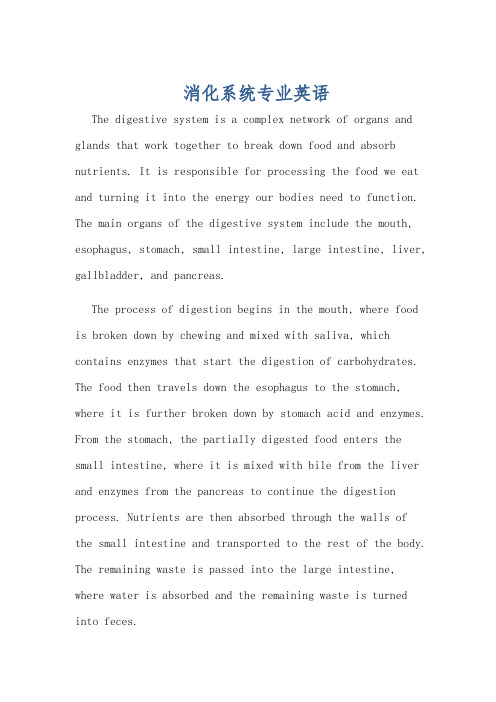
消化系统专业英语The digestive system is a complex network of organs and glands that work together to break down food and absorb nutrients. It is responsible for processing the food we eat and turning it into the energy our bodies need to function. The main organs of the digestive system include the mouth, esophagus, stomach, small intestine, large intestine, liver, gallbladder, and pancreas.The process of digestion begins in the mouth, where food is broken down by chewing and mixed with saliva, which contains enzymes that start the digestion of carbohydrates. The food then travels down the esophagus to the stomach, where it is further broken down by stomach acid and enzymes. From the stomach, the partially digested food enters the small intestine, where it is mixed with bile from the liver and enzymes from the pancreas to continue the digestion process. Nutrients are then absorbed through the walls ofthe small intestine and transported to the rest of the body. The remaining waste is passed into the large intestine, where water is absorbed and the remaining waste is turned into feces.The digestive system is essential for maintaining good health and any disruption to its function can lead to a range of health issues. Common digestive system disorders include acid reflux, irritable bowel syndrome, Crohn's disease, and ulcerative colitis. These conditions can cause symptoms such as abdominal pain, bloating, diarrhea, constipation, and nausea.To keep the digestive system healthy, it is important to maintain a balanced diet that includes plenty of fiber, fruits, and vegetables. It is also important to stay hydrated and to limit the intake of alcohol and processed foods. Regular exercise can also help to keep the digestive system functioning properly.Overall, the digestive system plays a crucial role in the overall health and well-being of an individual. By understanding its function and taking steps to keep it healthy, we can ensure that our bodies are able to effectively process the food we eat and absorb thenutrients we need to thrive.消化系统是一个复杂的器官和腺体网络,它们共同工作,将食物分解并吸收营养物质。
消化系统英文名称TheDigestiveSystem课件

stomach ▪kills germs ▪break up food ▪digest proteins ▪store food
Absorption in the SI
• Much absorption is thought to occur directly through the wall without the need for special adaptations
Liver
• Function
– produces bile
• bile stored in gallbladder until needed • breaks up fats
– act like detergents to breakup fats
bile contains colors from old red blood cells collected in liver =
BILE
• Bile emulsifies lipids (physically breaks apart FATS)
• Bile is a bitter, greenish-yellow alkaline fluid, stored in the gallbladder between meals and upon eating is discharged into the duodenum where it aids the process of digestion.
• Rectum- solid wastes exit the body.
You’ve got company!
消化系统疾病英文翻译
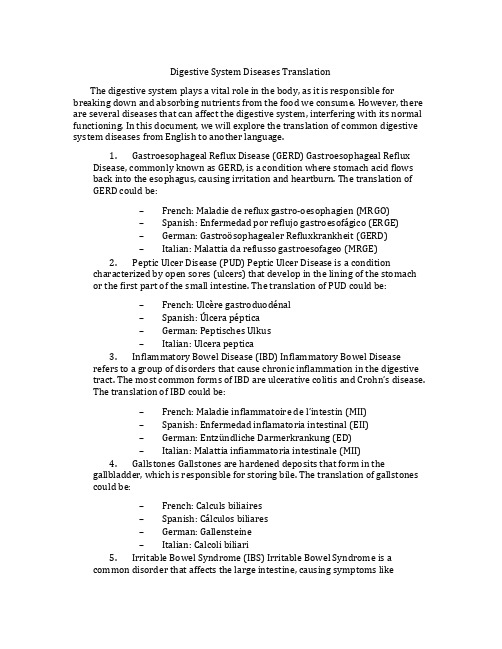
Digestive System Diseases TranslationThe digestive system plays a vital role in the body, as it is responsible for breaking down and absorbing nutrients from the food we consume. However, there are several diseases that can affect the digestive system, interfering with its normal functioning. In this document, we will explore the translation of common digestive system diseases from English to another language.1.Gastroesophageal Reflux Disease (GERD) Gastroesophageal RefluxDisease, commonly known as GERD, is a condition where stomach acid flows back into the esophagus, causing irritation and heartburn. The translation of GERD could be:–French: Maladie de reflux gastro-oesophagien (MRGO)–Spanish: Enfermedad por reflujo gastroesofágico (ERGE)–German: Gastroösophagealer Refluxkrankheit (GERD)–Italian: Malattia da reflusso gastroesofageo (MRGE)2.Peptic Ulcer Disease (PUD) Peptic Ulcer Disease is a conditioncharacterized by open sores (ulcers) that develop in the lining of the stomach or the first part of the small intestine. The translation of PUD could be:–French: Ulcère gastroduodénal–Spanish: Úlcera péptica–German: Peptisches Ulkus–Italian: Ulcera peptica3.Inflammatory Bowel Disease (IBD) Inflammatory Bowel Diseaserefers to a group of disorders that cause chronic inflammation in the digestive tract. The most common forms of IBD are ulcerative colitis and Crohn’s disease.The translation of IBD could be:–French: Maladie inflammatoire de l’intestin (MII)–Spanish: Enfermedad inflamatoria intestinal (EII)–German: Entzündliche Darmerkrankung (ED)–Italian: Malattia infiammatoria intestinale (MII)4.Gallstones Gallstones are hardened deposits that form in thegallbladder, which is responsible for storing bile. The translation of gallstones could be:–French: Calculs biliaires–Spanish: Cálculos biliares–German: Gallensteine–Italian: Calcoli biliari5.Irritable Bowel Syndrome (IBS) Irritable Bowel Syndrome is acommon disorder that affects the large intestine, causing symptoms likeabdominal pain, bloating, and changes in bowel habits. The translation of IBS could be:–French: Syndrome du côlon irritable (SCI)–Spanish: Síndrome del intestino irritable (SII)–German: Reizdarmsyndrom (RDS)–Italian: Sindrome dell’intestino irritabile (SII)6.Celiac Disease Celiac Disease is an autoimmune disorder triggered bythe consumption of gluten, a protein found in wheat, barley, and rye. Thetranslation of celiac disease could be:–French: Maladie cœliaque–Spanish: Enfermedad celíaca–German: Zöliakie–Italian: Malattia celiaca7.Hepatitis Hepatitis refers to inflammation of the liver, often caused byviral infections. The translation of hepatitis could be:–French: Hépatite–Spanish: Hepatitis–German: Hepatitis–Italian: EpatiteThese translations will be useful for individuals seeking information or medical assistance related to digestive system diseases in another language. It is important to consult with healthcare professionals for accurate diagnosis and treatment options.。
《消化系统英文版》课件

The gallbladder stores bill produced by the liver and releases it into the duodynum in response to signals from the small intent
03
Pancream
The pancras products enzymes that aid in protein, carbohydrate,
Digestive enzymes
Breaking down food into small particles through Chewing and mixing with Saliva
Secreted by the pancras, livers, and gallbladders to aid in chemical digestion
colonial utility
Elimination of waste
03
Formation of fees
Role of colon
Waste material that cannot be absorbed through the large intention where it is further processed and water is reabsorbed
Mouth
The Mouth is the opening at the antagonist end of the digestive tract It is lined by moist, pink mucosa and contains several sense receivers that aid in taste and touch The tongue is a muscular organization that aids in chewing, swinging, and speech
深入消化系统 英文作文
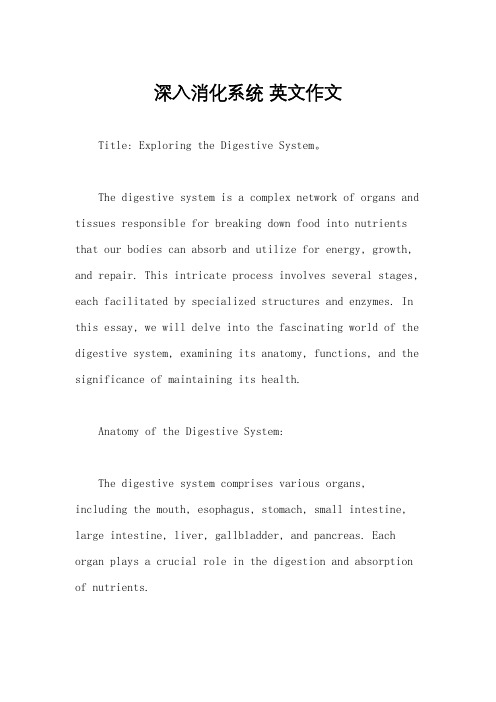
深入消化系统英文作文Title: Exploring the Digestive System。
The digestive system is a complex network of organs and tissues responsible for breaking down food into nutrients that our bodies can absorb and utilize for energy, growth, and repair. This intricate process involves several stages, each facilitated by specialized structures and enzymes. In this essay, we will delve into the fascinating world of the digestive system, examining its anatomy, functions, and the significance of maintaining its health.Anatomy of the Digestive System:The digestive system comprises various organs,including the mouth, esophagus, stomach, small intestine, large intestine, liver, gallbladder, and pancreas. Each organ plays a crucial role in the digestion and absorption of nutrients.1. Mouth: Digestion begins in the mouth, where food is broken down mechanically by chewing and chemically by enzymes in saliva, such as amylase, which initiates the breakdown of carbohydrates.2. Esophagus: Once swallowed, food travels down the esophagus through a series of muscular contractions called peristalsis, which pushes the food toward the stomach.3. Stomach: In the stomach, food mixes with gastric juices containing hydrochloric acid and enzymes like pepsin, which break down proteins into smaller molecules.4. Small Intestine: The majority of digestion and nutrient absorption occur in the small intestine. Here, enzymes from the pancreas and bile from the liver and gallbladder further break down carbohydrates, proteins, and fats into their basic components—glucose, amino acids, and fatty acids—allowing them to be absorbed into the bloodstream through the intestinal walls.5. Large Intestine: The remaining undigested foodpasses into the large intestine, where water and electrolytes are absorbed, and the waste material is formed into feces for elimination.6. Liver and Pancreas: These accessory organs playvital roles in digestion. The liver produces bile, which helps emulsify fats, while the pancreas secretes digestive enzymes and bicarbonate to neutralize stomach acid in the small intestine.Functions of the Digestive System:The digestive system serves several essential functions beyond digestion and absorption:1. Nutrient Absorption: Nutrients obtained from food are absorbed into the bloodstream and transported to cells throughout the body to support various physiological processes.2. Waste Elimination: The elimination of indigestible food residues prevents the accumulation of toxins andmaintains the body's overall health.3. Immune Support: The digestive system contains lymphoid tissue and beneficial bacteria that help protect against harmful pathogens and support immune function.4. Metabolic Regulation: Hormones released by the digestive organs, such as insulin and glucagon, help regulate blood sugar levels and metabolism.Importance of Digestive Health:Maintaining a healthy digestive system is crucial for overall well-being and longevity. Poor digestive health can lead to various disorders, including:1. Gastrointestinal Disorders: Conditions such as gastroesophageal reflux disease (GERD), irritable bowel syndrome (IBS), and inflammatory bowel disease (IBD) can cause symptoms like abdominal pain, bloating, and diarrhea, significantly impacting quality of life.2. Nutritional Deficiencies: Impaired digestion and absorption can lead to deficiencies in essential nutrients, resulting in fatigue, weakness, and compromised immune function.3. Digestive Cancers: Chronic inflammation and other factors associated with poor digestive health increase the risk of developing digestive cancers, such as colorectal cancer.Tips for Maintaining Digestive Health:To promote optimal digestive function and overall health, consider incorporating the following habits into your lifestyle:1. Eat a Balanced Diet: Consume a variety of whole foods rich in fiber, vitamins, and minerals to support digestive function and microbial diversity in the gut.2. Stay Hydrated: Drink plenty of water throughout the day to maintain hydration and facilitate the movement offood through the digestive tract.3. Manage Stress: Practice stress-reducing techniques such as meditation, deep breathing, or yoga, as stress can negatively impact digestion.4. Exercise Regularly: Engage in regular physical activity to promote healthy digestion and bowel regularity.5. Limit Trigger Foods: Identify and avoid foods that exacerbate digestive symptoms, such as spicy foods, caffeine, and alcohol, if you are sensitive to them.6. Seek Medical Advice: Consult a healthcare professional if you experience persistent digestive issues or symptoms that interfere with your daily life.In conclusion, the digestive system plays a vital role in maintaining our health and well-being by breaking down food, absorbing nutrients, and eliminating waste. Understanding its anatomy, functions, and the importance of digestive health empowers us to make informed choices thatsupport optimal digestion and overall wellness. By prioritizing habits that promote digestive health, we can enjoy a vibrant and fulfilling life free from gastrointestinal discomfort and disease.。
- 1、下载文档前请自行甄别文档内容的完整性,平台不提供额外的编辑、内容补充、找答案等附加服务。
- 2、"仅部分预览"的文档,不可在线预览部分如存在完整性等问题,可反馈申请退款(可完整预览的文档不适用该条件!)。
- 3、如文档侵犯您的权益,请联系客服反馈,我们会尽快为您处理(人工客服工作时间:9:00-18:30)。
h
15
肠
• 小肠:消化吸收的主要部位 • 圆口类、软骨鱼类、低等硬骨鱼类的小
肠后部有螺旋瓣
• 有些有胃鱼类的胃与小肠之间有幽门盲 囊
h
16
• 大肠:不明显 • 泄殖腔:圆口类及多数硬骨鱼类无,软骨
鱼类有 • 肠的长短与食性有关
h
17
第二节 消化腺
一、肝脏 二、胰脏
h
18
h
19
h
20
休息一下
消化系统 The digestive system
配合CAI课件材料
h
1
•功
能
• 能量是生命活动的第一需要。
• 主要功能是:摄取食物、进行消化,吸 收,营养全身;
• 残渣形成粪便,排出体外
• 解毒、抵御微生物侵害的功能
• 包括:消化管 消化腺
h
2
第一节 消化管
一、口咽腔:齿、舌、鳃耙 二、食道 三、胃 四、肠
h
3
h
4
齿
• 圆口类无颌,也无颌齿 • 软骨鱼类有由盾鳞演变来的齿,生于上
下颌 • 硬骨鱼类在上下颌、腭骨、犁骨、舌骨、
鳃弓等处都可能有。
h
5
狭纹虎鲨的下颌齿
h
6
h
7
h
8
h
9
h
10
舌
• 圆口类的舌有角质齿
• 其他鱼类的舌是由基舌骨突出部分覆以 黏膜构成,无弹性,缺乏活动能力;
• 但多鳍鱼和肺鱼的舌有肌肉,可活动。 多数鱼类 的舌前端游离,能上下活动, 如鳗鲡。
• 鲤科鱼类等不能活动。
h
11
h
12
口腔腺
• 圆口类舌下两侧有一对口腔腺,分泌物 为抗凝血剂,适于寄生。
• 其他鱼类只有单细胞黏液腺
h
13
• 鳃耙:过滤食物
• 食道:通道 • 胃:储存食物、初步消化 • 圆口类、全头亚Fra bibliotek(银鲛)、肺鱼、某
些硬骨鱼类等不具胃 • 板鳃亚纲、多数硬骨鱼类具胃
h
14
治疗多为对症治疗,药物包括制酸剂, H2拮抗 剂和质 子泵。 2. 慢 性 胃 炎的 癌变 对于胃溃疡发生癌变,人们比较容易理 解,但 对于有 些类型 的慢性 胃炎也 会发生 癌变, 许多人 会感到 不可思 议.然 而,慢 性萎缩 性胃炎 发生癌 变却是 事实
编辑本段现代中医史(df4肺炎88gdg青霉素d25f肝炎 df6) ④轴心 时代中 、西医 学的峰 巅之作 。雅斯 贝而斯 曾说: “如果 历史有 一个轴 心,那 么我们 就必须 将这轴 心作为 一系列 对全部 人类都 有意义 的事件 ,…… 发生于 公元前800至200年间 的这种 精神历 程似乎 构成了 这样一 个轴心 。
h
21
) “和而不同”,多元发展。近年来 ,中医 药在防 治非典 、禽流 感和艾 滋病方 面发挥 的独特 作用也 证实了 二者的 有机结 合,具 有肯定 的临床 疗效。 编辑本段东西方医学交融(df高血压958心脏 病983u6糖尿 病87fr)
不管是中医学还是西医学,从二者现有 的思维 方式的 发展趋 势来看 ,均是 走向现 代系统 论思维 ,中医 药学理 论与现 代科学 体系(45传染 病q566丙肝964jo乙肝 28jgsx甲肝gh)之间 具有系 统同型 性,属 于本质 相同而 描述表 达方式 不同的 两种科 学形式 。可望 在现代 系统论 思维上 实现交 融或统 一,成 为中西 医在新 的发展 水平上 实现交 融慢 性 胃 炎 分 类 慢性胃炎的命名很不统一。依据不同的 诊断方 法而有 慢性浅 表性胃 炎、慢 性糜烂 性胃炎 、慢性 萎缩性 胃炎、 慢性胆 汁返流 性胃炎 、慢性 疣性胃 炎、药 物性胃 炎、乙 醇性胃 炎等等 。 .
慢性胃炎大体可分为三种类型:慢性肥 厚性胃 炎、慢 性浅表 性胃炎 以及慢 性萎缩 性胃炎 。慢性 肥厚性 胃炎在 临床上 较为少 见,一 般也不 会发生 癌变。 慢性浅 表性胃 炎主要 是指胃 粘膜的 浅表性 炎症, 这类炎 症主要 表现为 胃粘膜 的固有 膜宽度 增大并 伴有水 肿,被 炎症细 胞浸润 ,但胃 腺体多 属正常 .这类 胃炎在 临床上 较多见 ,一般 也不会 发生癌 变。只 要经过 恰当治 疗之后 ,炎症 可消退 ,但如 治疗不 当,往 往可发 展成萎 缩性慢 性胃炎 .慢性 萎缩性 胃炎是 指胃粘 膜除有 浅表性 胃炎病 变外, 胃腺体 明显减 少,脉 管间隙 扩大, 胃粘膜 层有全 层性细 胞浸润 ,常伴 有肠上 皮化生 ,即胃 型上皮 变为肠 型上皮 .这种 性质的 慢性胃 炎与胃 癌的关 系密切 ,特别 是有肠 上皮化 生者更 是如此 .或统 一的支 撑点, 希冀籍 此能给 (df高 血压958心脏病 983u6糖尿病87fr)中 医学以 至生命 科学带 来良好 的发展 机遇, 进而对 医学理 论带来 新的革 命。 在胃镜问世以前,胃炎的主要诊断依据 是依靠 临床症 状和上 消化道 钡餐检 查。随 着纤维 胃镜的 临床应 用,特 别是经 胃镜对 胃粘膜 的活组 织检查 ,对越 来越多 的胃炎 有了较 明确的 认识。1982年 ,国内 胃炎会 议上根 据国内 外经验 ,将慢 性胃炎 分为浅 表性和 萎缩性 两大类 。而在 浅表性 胃炎的 命名上 ,又常 常使用 病理、 部位、 形态等 含义的 词,如 “慢性 疣状胃 炎”、 “慢性 出血性 胃炎” 、“慢 性糜烂 性胃炎 ”、 “慢性胆汁反流性胃炎”等等。1990年8月, 在澳大 利亚悉 尼召开 的第九 届世界 胃肠病 学大会 上,又 提出了 新的胃 炎分类 法,它 由组织 学和内 镜两部 分组成 ,组织 学以病 变部位 为核心 ,确定 3种基 本诊断 :①急 性胃炎 ;②慢 性胃炎 ;③特 殊类型 胃炎。 加上前 缀病因 学诊断 和后缀 形态学 描述, 并对炎 症、活 动度、 萎缩、 肠化、 幽门螺 杆菌感 染分别 给予程 度分级 。内镜 部分以 肉眼所 见描述 为主, 分别区 分病变 程度。 1. 慢 性 糜 烂性 胃炎 内镜下常表现为多发性点状或阿弗他溃 疡。慢 性非糜 烂性胃 炎可为 特发性 ,也可 由药物( 特别是 阿司匹 林和非 甾体类 消炎药 ,参见 消化性 溃疡的 治疗部 分), 克罗恩 病或病 毒感染 所引起 。幽门 螺杆菌 可能在 此不发 挥重要 作用。 症状多为非特异性的,可包括恶心,呕 吐和上 腹部不 适。内 镜下显 示在增 厚的皱 襞隆起 边缘有 点状糜 烂,中 央有白 斑或凹 陷。组 织学变 化多样 。尚无 某种方 法具有 广泛疗 效或可 治愈。
